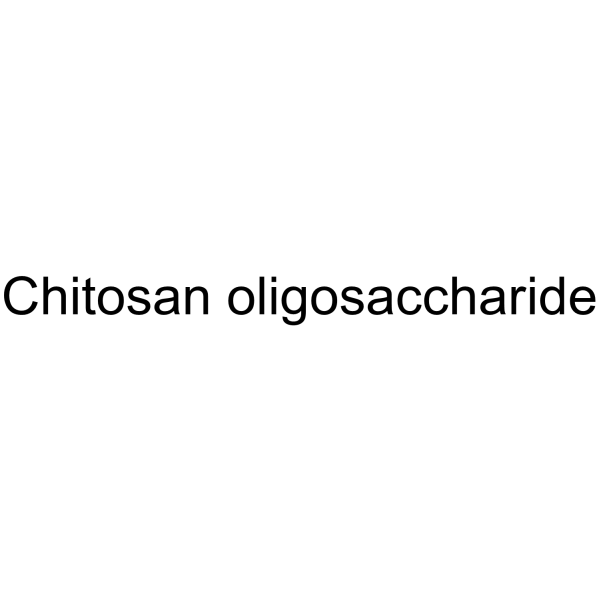上海金畔生物科技有限公司为生命科学和医药研发人员提供生物活性分子抑制剂、激动剂、特异性抑制剂、化合物库、重组蛋白,专注于信号通路和疾病研究领域。
Chitosan oligosaccharide (Synonyms: COS) 纯度: ≥91.0%
Chitosan oligosaccharide (COS) 是一种 由 β-(1→4) 糖苷键连接的 D-葡糖胺的寡聚物。Chitosan oligosaccharide (COS) 激活 AMPK 并抑制包括 NF-κB 和 MAPK 途径的炎症信号途径。

Chitosan oligosaccharide Chemical Structure
CAS No. : 148411-57-8
| 规格 | 价格 | 是否有货 | 数量 |
|---|---|---|---|
| 10 mg (10 mg/mL in Water) | ¥550 | In-stock | |
| 500 mg | ¥400 | In-stock | |
| 1 g | ¥500 | In-stock | |
| 5 g | ¥800 | In-stock |
* Please select Quantity before adding items.
Chitosan oligosaccharide 相关产品
•相关化合物库:
- Bioactive Compound Library Plus
- Epigenetics Compound Library
- Kinase Inhibitor Library
- NF-κB Signaling Compound Library
- PI3K/Akt/mTOR Compound Library
- Anti-Cancer Compound Library
- Anti-Aging Compound Library
- Antioxidants Compound Library
- Diabetes Related Compound Library
- Oxygen Sensing Compound Library
- Glycolysis Compound Library
- Cytoskeleton Compound Library
- Anti-Lung Cancer Compound Library
- Anti-Pancreatic Cancer Compound Library
- Anti-Blood Cancer Compound Library
- Anti-Cancer Metabolism Compound Library
- Anti-Obesity Compound Library
- Lipid Metabolism Compound Library
- Glucose Metabolism Compound Library
| 生物活性 |
Chitosan oligosaccharide (COS) is an oligomer of β-(1→4)-linked D-glucosamine. Chitosan oligosaccharide (COS) activates AMPK and inhibits inflammatory signaling pathways including NF-κB and MAPK pathways. |
IC50 & Target |
AMPK[1] |
||||||||||
|---|---|---|---|---|---|---|---|---|---|---|---|---|---|
| 体外研究 (In Vitro) |
Chitosan oligosaccharide (COS) represents a class of natural polymers that holds therapeutic promise in several diseases due to not only its physiochemical properties including water-solubility and low viscosity but also its favorable pharmacological properties including good pharmacokinetics and safety profiles and diverse beneficial biological activities. Activation of AMPK and inhibition of inflammatory signaling pathways including NF-κB and MAPK pathways are recognized as major mechanisms responsible for several effects of Chitosan oligosaccharide (COS) including anti-inflammation, anti-cancer, and anti-diabetes. COS can interrupt cancer progression at multiple stages by modulating several signaling proteins/pathways including NF-κB, AMPK, mTOR, caspase-3, CD147, MMP-2, MMP-9, and VEGF. In vitro experiments have demonstrated that Chitosan oligosaccharide (COS) induced the death of several cancer cell types including ascites, bladder cancer, prostate cancer, lung cancer, liver cancer, leukemia, cervical cancer and colorectal cancer. The values of IC50 of Chitosan oligosaccharide (COS) in inducing cytotoxicity are 25 μg/mL-50 μg/mL depending on types of cancer cells[1]. 上海金畔生物科技有限公司 has not independently confirmed the accuracy of these methods. They are for reference only. |
||||||||||||
| 体内研究 (In Vivo) |
The oral administration of Chitosan oligosaccharide (16 mg/kg/day) suppresses the production of the proinflammatory cytokines involved in allergic reactions, i.e., IL-4, IL-13 and TNF-α, in the lung tissues and bronchoalveolar lavage fluid of the mice. Last, an anti-inflammatory effect of Chitosan oligosaccharide (COS) on lymphocyte activation has been documented in a rat model of autoimmune anterior uveitis induced by immunization with bovine melanin-associated antigen[1]. Chitosan oligosaccharide (COS) inhibits UV-induced macroscopic appearance in mice skin. Compared with healthy dorsal skin with smoothness and some shallow wrinkles of hairless mice in normal control group, UV exposure for 10 weeks triggers skin erythema, dry, thickening, sagging and coarse wrinkles, and even leathery appearance and slight flesh-colored lesion in the model mice, the visual score of which is markedly higher than that of the normal control group (p<0.05), indicating that UV induces photoaging in skin surface[2]. 上海金畔生物科技有限公司 has not independently confirmed the accuracy of these methods. They are for reference only. |
||||||||||||
| CAS 号 |
148411-57-8 |
||||||||||||
| 运输条件 |
Room temperature in continental US; may vary elsewhere. |
||||||||||||
| 储存方式 |
|
||||||||||||
| 溶解性数据 |
In Vitro:
H2O : 50 mg/mL (Need ultrasonic) DMSO : 50 mg/mL (Need ultrasonic) In Vivo:
请根据您的实验动物和给药方式选择适当的溶解方案。以下溶解方案都请先按照 In Vitro 方式配制澄清的储备液,再依次添加助溶剂: ——为保证实验结果的可靠性,澄清的储备液可以根据储存条件,适当保存;体内实验的工作液,建议您现用现配,当天使用; 以下溶剂前显示的百
|
||||||||||||
| 参考文献 |
|
| Animal Administration [2] |
Mice[2] 上海金畔生物科技有限公司 has not independently confirmed the accuracy of these methods. They are for reference only. |
|---|---|
| 参考文献 |
|
所有产品仅用作科学研究或药证申报,我们不为任何个人用途提供产品和服务
